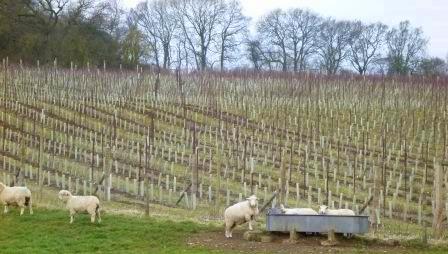Wine up north
(by peter)
 A listener texted in to Simon Mayo’s Radio 2 drivetime show to say they were indulging in some ‘Manchester wine tasting’. This got Simon thinking – what if they weren’t just doing some wine tasting in Manchester, but actually tasting wine grown and made in Manchester..?
A listener texted in to Simon Mayo’s Radio 2 drivetime show to say they were indulging in some ‘Manchester wine tasting’. This got Simon thinking – what if they weren’t just doing some wine tasting in Manchester, but actually tasting wine grown and made in Manchester..?
He got me on the show to ask how far north you can make good wine. (You can find the show online via the Radio 2 page, my bits at 18:00 until 22:25.) My initial response was that it entirely depends on what you mean by ‘good’.
It’s a contentious issue. A combination of global warming and passionate (some might say obsessive) wine lovers has pushed the frontiers of wine ever further back in recent years. Time was, most winemaking took place between two neat bands around the globe, one in each hemisphere. But those delimitations are no longer neat, or uniform, as people push the frontiers back in all directions. Recently in Chile I was tasting wines from a new vineyard at 46 degrees south, whose winemaker asserted it was the southernmost in the world (New Zealand’s Central Otago is around 45 degrees latitude).
But are these extreme wines any good?
The Chilean wines (from Chile Chico, incidentally) weren’t half bad – definitely zingy, but the Sauvignon Blanc and Pinot Noir were palatable.
 But as for the northern latitudes…it’s complex. There are vineyards in Yorkshire. I recently tried a Danish wine that was pretty filthy. I’ve heard from colleagues of some decent Swedish red. But I’m willing to bet that the wine made on the Olkiluoto nuclear power plant in Finland, apparently the northernmost vineyard in the world, is best drunk by nuclear physicists only.
But as for the northern latitudes…it’s complex. There are vineyards in Yorkshire. I recently tried a Danish wine that was pretty filthy. I’ve heard from colleagues of some decent Swedish red. But I’m willing to bet that the wine made on the Olkiluoto nuclear power plant in Finland, apparently the northernmost vineyard in the world, is best drunk by nuclear physicists only.
The problem is that, to make good wine, you need a decent amount of sun and warmth. Vines are pretty forgiving plants but vitis vinifera, the varieties that make the best wine, do not take kindly to frosts or hail during the growing season. Plus they need a certain amount of warmth, dryness and sun to give a relatively long growing season to create the flavours, textures and alcohol level necessary for balanced wine.
For example, top English fizz producer Nyetimber caused controversy (not to mention a huge financial headache for its owner Eric Hereema) when it announced it wasn’t making any wine from the 2012 vintage. As Cherie Spriggs explained, ‘The 2012 vintage was difficult because we had very high acidity and, more importantly, the flavours in the grapes hadn’t developed properly. As a result we couldn’t make the kind of quality we wanted.’
 This doesn’t mean that, with enough care and attention, you can’t make good wine in northerly latitudes. But you need an exceptional site, a lot of luck (not every year will give the right conditions) and pots of cash in order to ride the financial losses that a poor vintage, with minimal quantity and dodgy quality, can entail.
This doesn’t mean that, with enough care and attention, you can’t make good wine in northerly latitudes. But you need an exceptional site, a lot of luck (not every year will give the right conditions) and pots of cash in order to ride the financial losses that a poor vintage, with minimal quantity and dodgy quality, can entail.
But I also think it’s important to salute the indomitable pioneer spirit of those people pushing back the boundaries of wine. It takes considerable guts, time, money and energy – but you never know if you try. It’s not too long ago that we would have scoffed at anyone who declared they were going to make world-class wine in the UK.
Never say never, as the saying goes. As for Chateau Manchester – for now, I think I’d prefer to indulge in another local speciality: Manchester’s Finest real ale, made by the fine people at Hydes.
